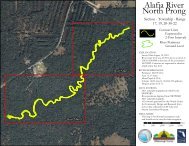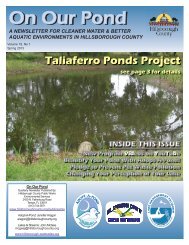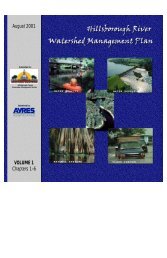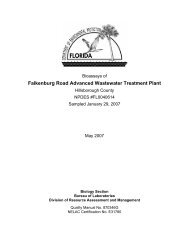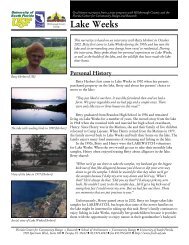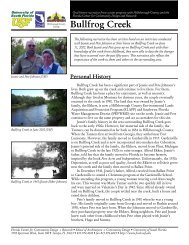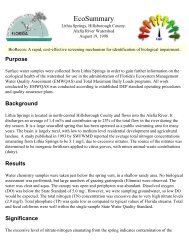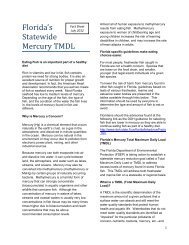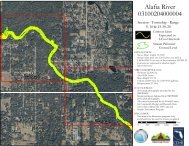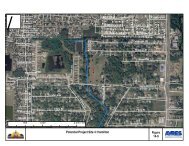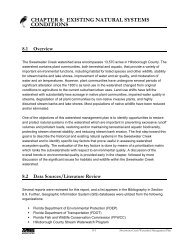Rocky Brushy Creek Watershed Mgmt. Plan (2007) -- Part 2
Rocky Brushy Creek Watershed Mgmt. Plan (2007) -- Part 2
Rocky Brushy Creek Watershed Mgmt. Plan (2007) -- Part 2
You also want an ePaper? Increase the reach of your titles
YUMPU automatically turns print PDFs into web optimized ePapers that Google loves.
EXISTING NATURAL SYSTEMS CONDITIONSTable 8-7 Recommended Buffer Widths (in meters)for protection of water quality and quantity and wetland-dependent wildlife habitat (fromBrown and Schaefer, 1987)Protect Water Quantity Protect Water Quality Protect Wildlife HabitatMinimize Groundwater Drawdown Control SedimentationLandscape Association (Habitat Type) Min. Max. Min. Max. Min. Max.Flatwoods/isolated wetlands 30 168 23 114 98 168Flatwoods/flowing-water wetlands 30 168 23 114 98 168Flatwoods/hammocks/hardwood swamps 15 76 23 114 N/A 168Sandhills/wetlands 6 76 23 114 98 223Flatwoods/salt marshes 30 168 23 114 98 N/ACoastal hammocks/salt marshes 30 168 23 114 98 N/AAVERAGE 24 137 23 114 98 182To calculate riparian zone widths and percentages of riparian zones that have been converted todevelopment in the <strong>Rocky</strong>/<strong>Brushy</strong> <strong>Creek</strong> watershed area, the ArcView buffer extension was used.First, 30m and 100m buffer zones were created around the stream network coverage that wascreated during the hydrologic analysis. From this coverage, the 2004 land use data were clippedfor each of the buffer zones and evaluated to determine percent of natural land cover within eachclipped area to develop a rating score (Figures 8-6 to 8-7). These scores were then converted tonumerical values and used in a natural systems evaluation matrix.Within the 100 m buffer encompassing 7923 acres, 46% (3,660 acres) of the land has beendeveloped for agricultural, commercial, or residential purposes, leaving 54% of the buffer area innative habitats. Within the 30 m buffer (2640 acres), 28% (742 acres) of the land has beendeveloped for agricultural, commercial, or residential purposes, leaving 72% of the buffer area innative habitats. It should be noted that much of the remaining native habitats have undergonedisturbance and encroachment, reducing their ecological value. Based on the riparian zoneanalyses, rating scores were developed for the <strong>Rocky</strong>/<strong>Brushy</strong> <strong>Creek</strong> watershed (Table 8-8). Thescore for the watershed was 2, giving the watershed a “fair” rating.Table 8-8Riparian Buffer Measures within the <strong>Rocky</strong>/<strong>Brushy</strong> <strong>Creek</strong> <strong>Watershed</strong>Excellent Good Fair Poor DegradedScoreVegetationIntact within100m buffer?80% of>60% of streamstream30m buffer intact for



